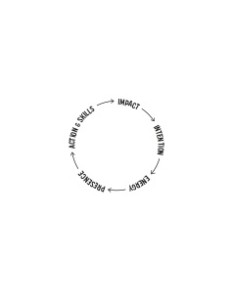How To Create A Positive and Contagious Culture
You’re contagious.
No, I’m not talking about a virus. But I am talking about the fact that you influence people in a way that you may not realize.
Anese Cavanaugh’s new book, Contagious Culture: Show Up, Set the Tone, and Intentionally Create an Organization that Thrives, is one of the best guides to understanding this influence and showing up in a way that generates positive energy. When a leader creates this positive presence, everything changes.
You can be that leader. You can be positively contagious.
Anese is a speaker, advisor, teacher, and thinking partner to some of today’s most innovative organizations. We recently talked about her book on creating a contagious culture.
Leaders Are Contagious
Let’s start with the first word in the title of your book, Contagious Culture. How are leaders contagious?
In so many ways: our mindset, our regard for others, our attitude, our energy – it’s all contagious. Going a bit deeper, I look at “contagious” in two ways: 1) how a leader makes others feel, and 2) how he or she influences how others show up by how he or she shows up.
A leader’s intention, energy, and presence has a big impact and huge influence on the people around her. It’s felt in her presence, how she shows up in a room, how she regards others. People respond to that and are either inspired and uplifted by it or demotivated and deflated by it. The minute a leader walks into a room he or she is setting the tone – if they’re in a good mood, people feel it. If they’re in a bad mood, people feel it. If they’re optimistic, people feel it. If they’re worried, people feel it. We are always having an impact with our presence and how we show up. This impact is felt by those around us and is often paid forward.
Just think of the last time you were in a conversation and in a good mood, and the person you’re talking to starts complaining or gossiping or their energy is just negative, and all of a sudden you start to find yourself complaining, gossiping, feeling negative. Or, you have a positive regard for someone in your company, and a leader in the company starts to “bad mouth” them – even in a lightly nuanced manner, and you start to feel your regard shift. You’ve “caught” that person’s state. We do it all the time. It’s easy to match a “low vibe” or “negative state.” We’re driving our kids to school and we’re in a funk, all of a sudden the whole car is in a funk. You’re in a great mood, your teenager is giving you grief, and slowly but surely you feel your energy start to drop and that good mood turns bad. The company is going through a challenging time, and the energy of doom and gloom starts to take over. Fortunately it works both ways… An executive with great energy and presence walks into a room, and all of a sudden the room feels lighter, creative, more alive. You’re in a funk, you have a quick chat with a colleague who’s got great energy, or meet a random stranger in an elevator who feels nice to be around, and voila, your state starts to shift. You’re feeling “ick” about one of your colleagues and someone shares positive regard for them, and you get a glimpse into another possibility.
At the end of the day when you want to look at how you feel walking away or walking into something (a conversation, a meeting, a room) – do you feel good, big, fuller, awake, expansive? Or do you feel exhausted, small, drained, yucky, constrictive? That’s energy – and it’s contagious. It works for the positive (it’s a super power) and it also works for the negative. Gossip, complaining, making stories up, regarding other people poorly, negative energy, these are all contagious and highly influential. Fortunately it works the other way too: accountability, seeing the good in people, optimism, and positive energy. We can choose which way we want it to go and that takes leadership.
5 Components of Showing Up With Intentional Energetic Presence (IEP)
You developed the 5 Components of Showing Up With Intentional Energetic Presence. How’d you develop this model?
 This came from experiencing for myself and watching over and over again with clients and our program participants the cycle of how I notice “impact” and “showing up” really happens – and what’s necessary to make it sustainable and effective. When I broke it down, I could see these 5 components forming a cycle. You can enter at any point, but you need all five. Some days, depending on where you’re at and what you need (and what the room, project, your team, or the other person needs), the entry point might be different.
This came from experiencing for myself and watching over and over again with clients and our program participants the cycle of how I notice “impact” and “showing up” really happens – and what’s necessary to make it sustainable and effective. When I broke it down, I could see these 5 components forming a cycle. You can enter at any point, but you need all five. Some days, depending on where you’re at and what you need (and what the room, project, your team, or the other person needs), the entry point might be different.
I find that intention and impact are really good book ends or anchors – what’s your intention for the impact you want to create? Your energy, your presence, and your actions & skills are going to help make it so. I noticed years ago that people often would go really heavy on one or two of these components, but they’d leave out the others and it would cost them – impact, relationships, peace, results – so I put them all together. These work with the IEP Leadership Model shared in the book, in that each level of the model helps strengthen and nourish these 5 components.
Choose Your Impact
You start by saying that you need to “choose your impact and how you want to show up.” Most of us don’t think about this consciously. Why is this the beginning and so important? Do some of your clients resist this?
This is important because the ability to choose how we want to show up is a super power (and it’s free with exquisitely high ROI). We’re all walking around with these amazing super powers and the ability to create impact. We’re having impact all the time – it’s either positive, negative, or beige, and we’re either contributing to helping things go better or worse (for ourselves and others) so why not be intentional about it?
We can choose how we want to show up before we walk into a room. We can choose how we want to handle something or respond to it and how we want to show up with it (even in the most difficult, unfortunate, unfair and painful of situations). We can choose how we want to impact another person (doesn’t mean we’ll be spot on – after all we can’t control how others respond to us — but giving it intention sets us up to be more likely to have that emotional impact).
To me this is the beginning, this awareness that we can choose how we want to show up. Once we get that, and really lean into it and own it – we can get to creating more intentionally across the board. Done proactively and intentionally it saves a ton of time, energy, money, and relationship equity. A bit of intention and awareness on the front end equals big returns on the back end.
Resistance? Absolutely. Sometimes people will resist it, but I find that more often it’s not resistance as much as a lack of awareness — they may not have been aware of their impact and that they had this choice to begin with. When there is resistance, it’s often because choosing our impact, and taking responsibility for how we show up, can be daunting. It can also be a lot easier to blame others for situations or to think that life is happening to us, or somebody is happening to us, or the life I’m unhappy about is happening to me. It’s way easier to point the finger outward as opposed to looking inward at how I might be contributing to my situation (in even the littlest way) by how I’m showing up. Or what hard decisions I may need to make now moving forward. It takes courage to pause and really look at that. Courage to own that I have choice in my life and that no m atter how horrible [this relationship] is or [this situation], even if it was not my fault and is truly out of my control, I can still make choices about how I want to be with it, how I’m going to show up, what I’ll need to do, what I might need to complete, what I’ll learn from it, and how I’ll move forward.
atter how horrible [this relationship] is or [this situation], even if it was not my fault and is truly out of my control, I can still make choices about how I want to be with it, how I’m going to show up, what I’ll need to do, what I might need to complete, what I’ll learn from it, and how I’ll move forward.
People often think it’s easier to blame or live in a place of it’s not my fault, it’s happening to me, they’re just bad to work with, life sucks… but really it’s not – it’s not easier – it can be pretty exhausting and hopeless. There’s huge power in honoring the present moment of what’s happening, being honest with yourself, claiming your choices, and being intentional about how you want to show up moving forward.
How to Increase Positive Energy
Energy. What steps can we take to improve how we show up and increase positive energy?
This requires an inside out approach. First, we have to be aware of how we’re feeling and how we’re showing up. Then it’s about setting ourselves up for success to show up well consistently and being able to reboot in the moment when we’re not. In the book I offer three frameworks to consider: 1) Presence Reboot, 2) 5-Steps to Impact, and 3) Your IEP Foundation. The Presence Reboot is about showing up in the moment and intentionally shifting your state when you have to be “on.” The 5-Steps to Intentional Impact is about setting yourself (and your team) up for success by being proactive and intentional about the impact, energy, and outcomes you’re going to create in a meeting. And then there’s the bigger picture — which is always happening, every day and every minute (or not) — which is about building a strong IEP foundation and setting yourself up for success by the way you take care of yourself, the food you eat, the people you surround yourself with, the way you manage your mindset and talk to yourself, etc. When we put these three together, we have a more holistic and sustainable approach to showing up more powerfully and creating more positive energy in our world.
Quickly Change Your Energy
If you notice low or negative energy in a meeting, what can you do to change it quickly?
There are all sorts of ways; really it depends on the group and the context of what’s happening (which, if you’re a present leader and in tune, you’ll be able to identify more accurately). Here are a couple of common places to look/play with. First, just notice it. Don’t judge it – just get curious. What’s going on in the room? Sometimes just you noticing it and getting curious (even just internally) is enough to shift the energy in the room. If that doesn’t work, hold your state (so you’re not going to go low or “match” their energy in order to “go get them”) and check in with the group. How’s it going? Where’s everyone at? How are they feeling about [whatever you’re working on]? If that doesn’t work, name it… Hey I’m noticing we seem to be bumping up against this… or we feel a bit off here… or… George, do you need anything? And if that doesn’t work, take a break, invite the person in question aside, and get curious. Sometimes they’re not even aware of their impact; sometimes they’re not aware they’re the lowest energy in the room, and sometimes they are and there’s value in exploring it.
These “steps” can all happen in order or blended or whatever you intuitively sense is needed in the room. The number one rule is don’t get hooked, stay curious, stay in service of, and hold your state. Often negative energy will get “handled” when you hold your space and don’t “match” it; the person with negative energy will shift on their own. And if not, a curious non-confrontational conversation will not only often shift the energy but sometimes will unearth bigger issues that are percolating through the team.
Improve Your Leadership Presence
What improves leadership presence?
Regard, awareness, physicality, and intention. These four to me are fundamental because if you can get these, then it becomes easier to address things like physical presence, commanding a room, and having awesome leadership skills. Regard is how you see people – truly see and think of them. Awareness is simply having the awareness of how you’re showing up and that you DO have impact with your presence. Physicality is about being IN the body, breathing, using your body to support you – your ribcage, your feet, your spine, your breath, your posture, how you FEEL in your body — all of it – even thinking about all this brings you to a new level of presence. And intention is about deciding what you want to have happen. How you want to show up. And the intent you hold for your people and for those around you, for the project, the company, the client, etc.… these four things are always operating under the surface and speak volumes. Get these handled, and any other skills you’d use to amplify leadership presence will be easier and more powerful.
 We share a love for Zingerman’s. What is it that makes this a great example of aContagious Culture?
We share a love for Zingerman’s. What is it that makes this a great example of aContagious Culture?
Zingerman’s simply emits positive energy. They’ve done a great job integrating intentional energy work and presence reboots into the organization. They care. A ton. From the minute you walk in the door of any of their businesses you feel it. Have a one-on-one conversation with one of their co-founders – it’s there. A heart-to-heart or business chat with any of their managing partners – there again. An interaction outside the Roadhouse or the Bakehouse (or any of their magical spots) with one of their team members – and there it is again. Energy, mojo, positive intent. You can’t walk away from an interaction without feeling good. The way they show up, the regard they hold for their customers and each other, and the joy of the work they’re doing – and their belief in it, all contributes to a positively contagious culture.
Contagious Culture: Show Up, Set the Tone, and Intentionally Create an Organization that Thrives

